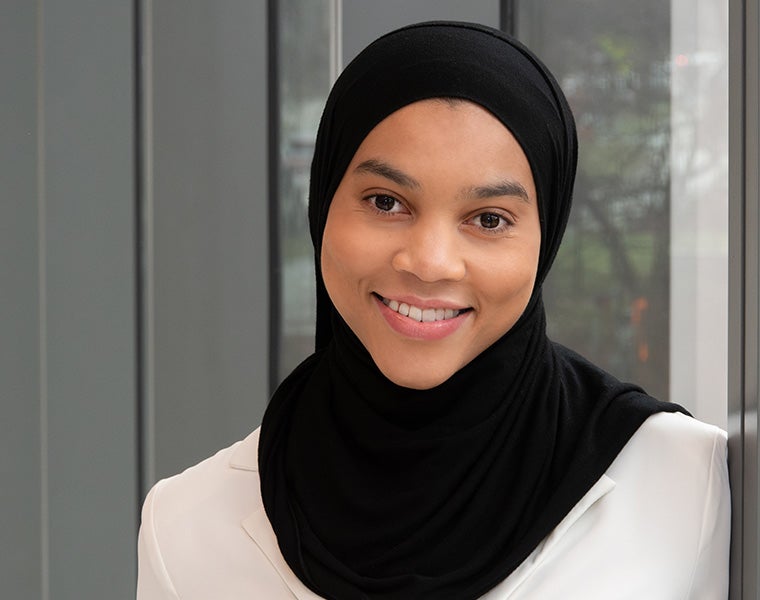As a high school student in Cleveland, Zaynab B. Shaheed was concerned by the tobacco-use rates amongst her peers. Her dismay heightened when, as a sophomore, she witnessed firsthand the devastation tobacco addiction can cause when her great uncle died.
Now a fourth-year student majoring in nutritional biochemistry and metabolism on the pre-med track at Case Western Reserve University, Shaheed is pursuing advocacy work to help combat tobacco use.
She got an early start in research as a part of the university’s Scientific Enrichment and Opportunity/Youth Engaged in Science program while still in high school. From 2018 to 2021 she engaged in research on a variety of topics, including pathology, genetics and genome sciences.
When the time to choose a college came, CWRU was the clear choice as it allowed Shaheed to remain close to her family and the community in which she grew up.
“It makes it very feasible for me to be involved in making contributions to my city and giving back!” she said.
She’s gotten a head start with advocacy on the City of Cleveland’s Tobacco 21 initiative. Earlier this year, the American Heart Association recognized Shaheed with an advocate spotlight piece.
In the fall, Shaheed plans to begin working toward a Master of Public Health degree to allow her future work as a physician to include population-level work to address tobacco addiction through policy.
“[My] vision is to identify barriers to equitable representation in health policy, establish accountability metrics for systemic infrastructure and ensure sustainable practices for better health outcomes in underrepresented communities,” Shaheed said. “I look forward to a promising career that intersects both medicine and public health!”
Learn more about Shaheed’s advocacy work.
Answers have been lightly edited for clarity and length.
1. When did you realize you’d like to be a physician?
I have always been interested in pursuing medicine as a career since I was a kid; I was really fascinated by the sciences and wanted to learn more about the human body. Of course, this led to an appreciation for the biomedical sciences as well as research, which is why I decided to pursue nutritional biochemistry and pre-med at CWRU.
2. Can you describe your advocacy work so far?
In February 2023, I was introduced to advocacy work with American Heart Association by delivering public comments with Cleveland City Council for introducing a policy that would require a tobacco retail license for inner-city retailers as well as a tobacco flavor ban.
I was invited to participate in bi-weekly coalition calls with the Coalition To End Tobacco Targeting where we would provide updates on the current tobacco-related legislation and community events to raise awareness. I volunteered to table at local events in Cleveland and was invited to table at local high school events to share cessation resources, informational material and further raise awareness of the dangers of tobacco and other nicotine products.
I also published an op-ed to The Plain Dealer (cleveland.com) to further raise awareness of the increasing issue of tobacco and its impact on our Cleveland youth population.
3. How do you plan to integrate public health into your career as a physician?
Pursuing a Master of Public Health (MPH), which will begin this Fall 2025, with a focus on health policy, will allow me to address health disparities on a larger scale. My background in medicine as a physician would give me insight into patient care, and by focusing on policy, I can work to remove barriers to equitable healthcare. I aim to create accountability and sustainable practices that improve healthcare systems and outcomes for underserved and vulnerable communities.
4. Are you involved in research at CWRU? If so, can you explain what you’re working on?
Aside from my background in biomedical research, I transitioned to focus on population health research in my junior year at CWRU. I was a research associate on the University Hospitals’ EMPOWER Quality Improvement Study at our Prevention Research Center for Healthy Neighborhoods (PRCHN). I also assisted in developing a Toolkit for Identifying Research Priorities that complemented such research endeavors.
Additionally, I was able to pick up a research project that examined the impact of Tobacco21 health policy on the use of tobacco and cannabis amongst local adolescents at the PRCHN for summer 2024 as an AHA SURE Scholar, which had further heightened my awareness of health policy impact on health outcomes especially for minoritized populations. For this research, I have two manuscripts being reviewed for publication. I also had my abstract invited to be presented at the American Heart Association Scientific Sessions Conference in Chicago November 2024.
5. Are you involved on campus in any other ways?
I have contributed and have been involved on our campus in a different way: I functioned as a volunteer teaching assistant for Professor Dr. Catherine Stein’s course MPHP 301: Introduction to Epidemiology in Fall 2024. Additionally, I functioned as a training manager for late distinguished faculty Dr. Nathan Berger’s Community Engaged in Cancer Research Program (SEO/YES) from fall 2023 to spring 2024, during which time I led 13 talented local high school students. Having once been a part of this program as a high schooler, I wanted to give back and further contribute to the field by increasing awareness of community-based research and its importance in health outcomes by leading this cohort.


